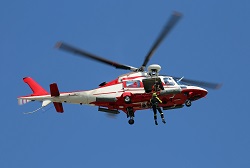Improved Search and Rescue with wrist-worn Personal Locator Beacons
In the 1980s, the international Cospas-Sarsat satellite system was set up to offer free, global Search and Rescue (SAR) services, helping people in distress, anytime and anywhere. The system, combines GPS technology, operated by the United States Airforce, with the European, Galileo and Russian, Glonass satellites. The distress signals which are picked up can be emitted by terminals onboard ships (Emergency Position Indicating Radio Beacons - EPIRBs) and airplanes (Emergency locator transmitters - ELTs), or by devices carried by individuals (Personal Locator Beacons - PLBs). The EU-funded SAT406M project has redesigned PLBs to be more user-friendly and compact, so that they can be continuously carried. The resultant wrist watch also integrates the SAR/Galileo Return Link Service (RLS). Beyond the product, the team developed updated SAR location methods which they are advocating be formally adopted. A product enhancing SAR efforts People, ships, and aircraft in distress have to be located as quickly as possible. The most common way of enabling this is to carry beacons (PLBs, EPIRBs or ELTs) that broadcast short radio signals, relayed by satellites to be detected at base stations. These stations pinpoint the beacon’s location and send alerts to the nearest Rescue Coordination Centre (RCC), responsible for deploying national SAR units or engaging others through international agreements. However, it has been recognised that current SAR beacon systems need to be improved. SAR scenarios at the bottom of a canyon, within a forest or after a plane crash, all too frequently result in distress signals that are both hard to locate and leave the vulnerable sender uncertain that the signal has been received. Putting the impetus for SAT406M into sharp relief, project coordinator Mr Daniel Katz outlines a scenario, “Imagine that you have fallen overboard five Nautical Miles off-shore. You are wearing a wrist PLB, activated to emit a distress signal every minute by raising your hand above water, but you face a dilemma: do you swim towards shore, weakening the signal by submerging it, as well as expending energy, or do you wait to be rescued?” To mitigate this dilemma, and key to the product’s success, the Return Link Service (RLS) recently launched via the EU Galileo satellites, was integrated into the device. RLS enables PLBs to receive an acknowledgement that the alert has been detected and located, meaning that a rescue operation should be underway. In the aforementioned scenario this would make the decision to wait, easier to make. The more general system improvement studied in SAT406M is based on a mathematical concept, embodied in software algorithms running in the beacon and base station which enhance remote beacon location in poor conditions and enable independent on-scene location. The latter is particularly important, as effective SAR requires beacon location also on-board SAR helicopters and vessels, which has previously been inadequately achieved. Testing the technology involved transmitting thousands of short radio bursts from the beacon, from different parts of the world, which were then relayed by Galileo satellites and detected at the MEOLUT base station in Toulouse-France. These signals were routed via the Internet to the project teams’ server to be analysed for debugging and further enhancements. Pressing the need for standardisation By being both wrist-wearable and RLS enabled, the new SAT406M PLB, built by Mobit, will improve rescue operations, ultimately saving more lives, while reducing government operating costs. The accompanying protocols for remote beacon localisation, on-scene beacon localisation and for communicating Extra Information Bits (EIB) in the narrow-band satellite system of Cospas-Sarsat, also have clear potential to enhance the SAR system, so the team are proposing their standardisation. However, as Mr Katz explains, “Standardising our methodology is challenging because the adoptive body, Cospas-Sarsat, is an international organisation comprising 44 members. This makes for slow progress with negotiating changes. Also, requirements for backwards compatibility might postpone acceptance, but we will all continue to press for standardisation which is a must for a win-win solution.”







